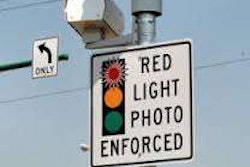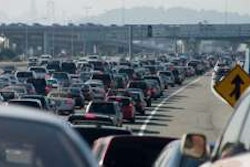More than two-fifths of Maryland’s major locally and state-maintained roads are in either poor or mediocre condition, one-quarter of bridges are in need of repair or replacement, and the state’s drivers experience increasingly worsening congestion, according to the report, Maryland Transportation by the Numbers: Meeting the State’s Need for Safe and Efficient Mobility, release Feb. 28 by TRIP, Washington, D.C.-based national transportation organization
In addition to deteriorated roads and bridges, Maryland’s rural roads have a significantly higher traffic fatality rate than all other roads in the state, according to the report.
TRIP says in the report that increased investment in transportation improvements could “improve road and bridge conditions, ease congestion, boost safety, and support long-term economic growth in Maryland.”
This report provides data on the following key transportation facts and figures in the state:
|
$6.2 |
TRIP estimates that Maryland roadways that lack some desirable safety features, have inadequate capacity to meet travel demands or have poor pavement conditions cost the state’s residents about $6.2 billion annually in the form of additional vehicle operating costs, the cost of lost time and wasted fuel due to traffic congestion, and traffic crashes. |
| $1,781
$2,195 |
Driving on roads that are congested, deteriorated and that lack some desirable safety features costs the average Baltimore area driver $1,781 annually due to deficient roads, while deficient roads cost the average Washington, D.C., area driver $2,195 annually. |
| 41%
66%
62% |
Forty-one percent of Maryland’s major locally and state- maintained roads and highways are either in poor or mediocre condition. Sixty-six percent of Baltimore-area major locally and state- maintained urban roads are in poor or mediocre condition and 62 percent of Washington urban area major locally and state- maintained urban roads are in poor or mediocre condition. |
| 579
2,897 |
From 2006 to 2010, an average of 579 people were killed annually in Maryland traffic crashes, a total of 2,897 fatalities over the five year period. |
|
2 ½ |
The fatality rate on Maryland’s non-interstate rural roads is nearly two-and-a-half times higher than on all other roads in the state (1.67 fatalities per 100 million vehicle miles of travel vs. 0.69). |
|
1 / 4 |
A total of one quarter of Maryland bridges are in need of repair, improvement or replacement. Seven percent of the state’s bridges are structurally deficient and 18 percent are functionally obsolete. |
| 39 %
20 % |
Vehicle miles of travel in Maryland increased 39 percent from 1990 to 2011 and are expected to increase another 20 percent by 2030. |
| 3,856,604 |
There are 3,856,604 licensed drivers in Maryland. |
| 81 % |
Eighty-one percent of goods shipped annually from sites in Maryland travel by truck. |
|
$1.00 = $5.20 |
The Federal Highway Administration estimates that each dollar spent on road, highway and bridge improvements results in an average benefit of $5.20 in the form of reduced vehicle maintenance costs, reduced delays, reduced fuel consumption, improved safety, reduced road and bridge maintenance costs, and reduced emissions as a result of improved traffic flow. |
“Today we face traffic gridlock – the worst in the nation. Tomorrow, without sufficient funding to support our infrastructure needs, we may face economic gridlock that will cost us far more,” said Douglas M. Duncan, chair of the Suburban Maryland Transportation Alliance, in a written statement.
Maryland roadways that lack some desirable safety features, have inadequate capacity to meet travel demands or have poor pavement conditions cost the state’s residents nearly $6.2 billion each year in the form of additional vehicle operating costs, the cost of lost time and wasted fuel due to traffic congestion, and traffic crashes. Driving on roads that are congested, deteriorated and that lack some desirable safety features costs the average Washington, D.C., area driver $2,195 annually due to deficient roads.
According to the TRIP report, 41 percent of Maryland’s major locally and state-maintained roads are in either poor or mediocre condition. In the Washington, D.C., metro area, 62 percent of roads are in poor or mediocre condition, according to the report.
A total of 25 percent of Maryland’s bridges show significant deterioration or do not meet modern design standards. Seven percent of the state’s bridges are structurally deficient, which indicates that there is significant deterioration of the bridge deck, supports or other major components. An additional 18 percent of Maryland’s bridges are functionally obsolete. These bridges no longer meet current highway design standards, often because of narrow lanes, inadequate clearances or poor alignment. (For more on the state of Maryland and Washington, D.C., bridges as well as throughout the nation, see Better Roads‘ Annual Bridge Inventory, published each year in the November issue.)
Growing traffic congestion, particularly in the state’s urban areas, threatens to choke commuting and commerce. The average commuter in the Washington, D.C., metro area loses 67 hours each year stuck in congestion.
Traffic crashes in Maryland claimed the lives of 2,897 people between 2006 and 2010. The state’s traffic fatality rate of 0.88 fatalities per 100 million vehicle miles of travel (VMT) is lower than the national average of 1.11 fatalities per 100 million VMT. However, the traffic fatality rate in 2010 on Maryland’s non-Interstate rural roads was 1.67 traffic fatalities per 100 million vehicle miles of travel, nearly two-and-a-half times higher than the 0.69 traffic fatalities per 100 million vehicle miles of travel on all other roads and highways in the state. Roadway features are likely a contributing factor in approximately one-third of all fatal and serious traffic crashes. Where appropriate, highway improvements can reduce traffic fatalities and crashes while improving traffic flow to help relieve congestion.
Traffic safety in Maryland
|
Year |
Fatalities |
|
2006 |
652 |
|
2007 |
614 |
|
2008 |
591 |
|
2009 |
547 |
|
2010 |
493 |
|
Total |
2,897 |
“These key transportation numbers in Maryland add up to trouble for the state’s residents in terms of deteriorated roads and bridges, reduced traffic safety and constrained economic development,” said Will Wilkins, executive director of TRIP, in a press release. “Improving road and bridge conditions, improving traffic safety and providing a transportation system that will support economic development in Maryland will require a significant boost in state and federal funding for road, highway and bridge improvements.”














